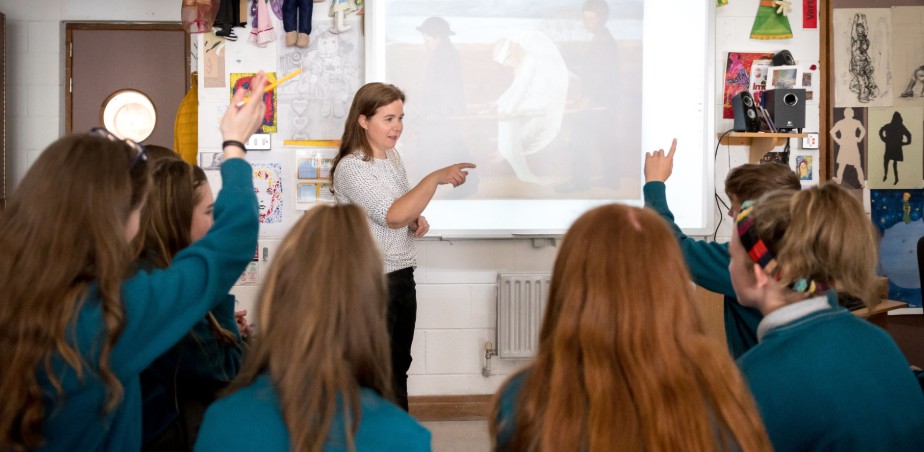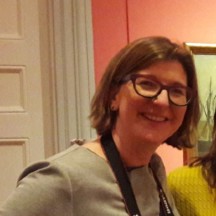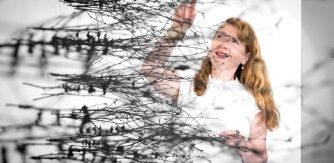Blog 2 – Liz Coman, Assistant Arts Officer Dublin City Council & VTS Facilitator

Image copyright: Dublin City Arts Office - Art Teacher Anne Moylan with pupils from Hartstown Community School.

Liz Coman is an Assistant Arts Officer with Dublin City Council. She is a certified Visual Thinking Strategies facilitator with VTS/USA and has completed training to coaching level. She is responsible for monitoring the quality of Erasmus+ Permission to Wonder – an EU project for Dublin City Council that is testing the VTS training pathway with educators in classroom and gallery settings. Liz has a background in History of Art and Museum Studies and fifteen years experience in designing innovative projects that support arts, education and learning. She has led trainings in enquiry led approaches to mediating artwork for visual art facilitators in The Ark, A Cultural Centre for Children, The National Gallery of Ireland, and The Turner Prize, Derry and offers ongoing mentorship for individual artists, arts educators and teachers.
Stepping Back – Erasmus+ Permission to Wonder in a Post Primary School Art Room
A conversation with Anne Moylan, Art Teacher, Hartstown Community School, Clonsilla, Dubln15.
My experience with VTS has taught me that supporting authentic VTS practice, for our educators, our students, and myself is not a linear process. It thrives on a spirit of collaboration, time, and some resources to access training and share understandings of the method.
In 2016, Dublin City Arts Office piloted a partnership approach with the NCCA to test the VTS training pathway with a group of Irish educators from different backgrounds – professional educators who are from early years settings; primary school classroom teachers; secondary school (art) teachers; art educators (freelance museum and gallery educators, including teaching artists). It supported professional educators to train in Visual Thinking Strategies via Beginners and Advanced Practicums, with VTS/USA Programme Director, Yoon Kang O’Higgins. Erasmus+ Permission to Wonder extended this approach to six European partners, allowing us to deepen our understanding of the educators’ VTS practice journey through a research evaluation framework led by our partners, VTS Nederland. The intended impact is that, through supporting educators, children and young people will have access to opportunities for critical thinking & thoughtful citizenship; will be actively encouraged to trust their own perceptions and be open to the thoughts of others; will feel their observations are valued and valuable when dealing with visual expression.
Change has been apace in secondary school curriculum re-design in Ireland in recent years. The ‘new’ Junior Cycle places an emphasis on students’ holistic development, linking subject areas, and turning a titanic history of ‘information giving’ towards scaffolding students’ life skills to equip them for a rapidly changing technological and global world. This is a welcome change, and long awaited by us in the field that bridges arts, education and learning. It also invites challenging questions. I wonder what really happens in the classroom when we ‘step back’ and support our students to take the lead? In my conversation with Anne Moylan, a secondary school art teacher, and educator participating in Permission to Wonder, we discuss how her training in VTS has supported a shift in her teaching practice and heightened her awareness of the value of “stepping-back” for her students.
How does VTS inform your teaching practice?
For me, the method is very much about stepping back. It has definitely simplified down the process of looking at a painting, an object, a sculpture, piece of assemblage, for the first time. To ask the question – what is going on in this work? – and then to actually hear what the students can see and what they are thinking about it. You always come with your own knowledge but in a VTS image discussion you have to step back out of that. It is about allowing them to take you on any sort of a journey with their observations.
It is surprising when they point out something that you haven’t thought about or know already. You have to be prepared to go with the flow and therefore, your role completely changes with your students. You can make connections, bridge comments and themes, always developing the journey of their observation of the artwork. At the beginning, I found this difficult. Sometimes, as teenagers, you will find they are quiet or are afraid they are going to make a mistake. That really gets easier with experience and practice as the students get used to the process over time.
We are not looking at images on the art history course. These are images from the VTS/USA website or the Permission to Wonder project, chosen specifically for use in a VTS image discussion. They are images that I am not familiar with myself. So, I am out of my comfort zone. I find this invigorating.
*Permission to Wonder partners are building and testing a European based image bank specifically for use within the project by the educators. This will be available shortly on the project website www.permissiontowonder.com. Other images we have practiced with are drawn from the VTS/USA image curriculum for specific age groups available on https://vtshome.org/
What have you noticed happening for your students in a VTS image discussion?
Often, in a VTS session, you will find that students, who are very quiet usually, will begin to have a lot to say about a work. Some of these students would never talk, even in a practical art class. Then you show them an image, something will strike them in that image, and they really want to let you know what they see in it.
I have a number of students whose first language is not English. They have difficulty trying to say what they are looking at in their second language. Yet VTS gives them the space to do this. The atmosphere is very calm. That is the shift for me. Instead of giving them facts, dates and information about artwork, you are waiting to find out what they want to say about it, first and foremost.
With VTS, you really are connecting with their world. VTS allows the space for their world to connect with an artwork and indeed with me, as somebody from a different generation. You just see into their minds. Therefore, you could show them an image and the theme of mental health or family issues might come through from them. Of course you have to be careful and manage the discussion, not to flinch or be surprised. You might be flummoxed by what might come out of them. So holding your neutrality, and keeping the space safe for students, is important. VTS training helps you learn to do this effectively. You sometimes think they might be talking about their own lives, and yet they are not, they are talking about an artwork.
Your role becomes very much the facilitator of the discussion. Often I would have students, saying to me ‘When can we do this again?
Have you practiced VTS with images that are on the art history course?
Yes, for example, with Jan Van Eyck’s Arnolfini Wedding. When you ask the first question – what is going on in this work?- you get “I know all about this, we studied this in religion / we studied this in history”. This is an image that is a little bit recognisable to them. They are able to share what they have been taught. However, when you manage the discussion with conditional paraphrasing and ‘What more can we find?’ it deepens their engagement with the work. Even though they think they know as much as there is to know about it, it refocuses their attention back on the image. It deepens their concentration and gets their eyes back on the key elements of the picture.
‘The Arnolfini Wedding’ by Jan Van Eyck
https://www.nationalgallery.org.uk/paintings/jan-van-eyck-the-arnolfini-portrait
As part of teaching art history, I take the opportunity to bring the students into galleries in Dublin. The guides tend to lead the tour with one voice- the guides voice. As an art teacher, I just want them to know you can walk into a gallery in any city, you do not have to pay, you can go in, see two pieces, and go back out again. With VTS and the three questions, it is a framework for them to use for looking at artwork, no matter where they are or what artwork they are looking at.
Can you recall a favourite VTS image discussion?
I have used VTS with all the year groups. However, I particularly remember a VTS discussion with a group of sixth years, at the end of the year, in May. We were finished the practical side of the preparation for the exam. With sixth years, you do not want to make anybody have to speak. It is fine if they don’t want to say anything. However, in this session, there was one boy from China. He had so much to say about a particular image. He related it back to his own country. It was a painting, with a bright yellow palette and all the children depicted had these red neckerchiefs. The Irish children read them as the scouts, or being members of a group, or a club. This boy went in a completely different direction. He described that this is what it is like in China, in school. He talked about his own experience. He spoke for a few minutes and got a round of applause from the other students. A girl in the group said to him ‘in all the years that you have been in the school, that is the most, I’ve ever heard you say’. So that is the kind of profound experience I remember coming from my VTS image discussions.
‘Mask Series No. 6’ by Zeng Fanzhi,
https://muse.union.edu/aah194-wi19/2019/01/30/zeng-fanzhi-mask-series-no-6/
How do you think VTS complements the Junior Cycle art curriculum?
In the new junior cycle art curriculum, student voice is very important. It means stepping back and letting the student do the work, lead their learning process. This does not mean that your job is easier. Within the structure of classroom-based assessment, a lot of reflecting, verbalizing and building the visual vocabulary for teachers and the students, is required. The change is that you are putting the ownership for their learning and describing their learning process back on the student. Therefore, you need to facilitate the classroom environment more in order to achieve that.
What we are all nervous about is that it this is difficult to assess. For students and parents it is difficult to understand this change in emphasis. I gave my students a VTS image discussion as a piece of homework to try out with their parents. They took the framework and used it to look at any artwork or any piece of visual information with their family. The students were surprised with their parent’s observations and the conversations about the art work at home. I use it with my own family and it works very well!
How did Erasmus+ Permission to Wonder help you develop your VTS practice?
I really value that I have been involved in Permission to Wonder. As an art teacher in a school, you might be the only art teacher. You could be on your own, in your creative world. You are so busy day to day with project work. It is amazing to step out of it with VTS and to have an opportunity to meet other educators-to look at artwork with them using a different format. It is really quite enlightening and refreshing. There are four of us educators from Dublin and we are all coming from completely different backgrounds – gallery, artist, primary school and secondary school. Being involved in our own Irish group was brilliant. We helped each other to explore our own context and look at theirs. I really enjoyed the collaboration and it was invigorating to explore art with others.
The training practicums were very well paced out. In the Beginners Practicum, you had the three questions. But you have to get them right, and in the right order, remember the exact wording, and that was tricky for me in the beginning. It was also a challenge to learn to paraphrase accurately. That requires a lot of skill. In the Advanced Practicum, I loved learning about linking and framing comments. How you, as facilitator, can connect comments and really build the learning in the group. I enjoyed the training and understand that it is also up to me to support my own practice and keep motivated in using VTS.
What would you like to work on next in your VTS practice?
I did a VTS session with a society and politics class. None of these students were art students. We looked at images I selected specifically looking at politics and society – race, childhood issues, gender etc. VTS worked so well in this class. Students had so much to say and the images stimulated insightful conversations. I am interested in how VTS could be used in other subject areas and how I might help other teachers integrate VTS into their subjects in our school.


